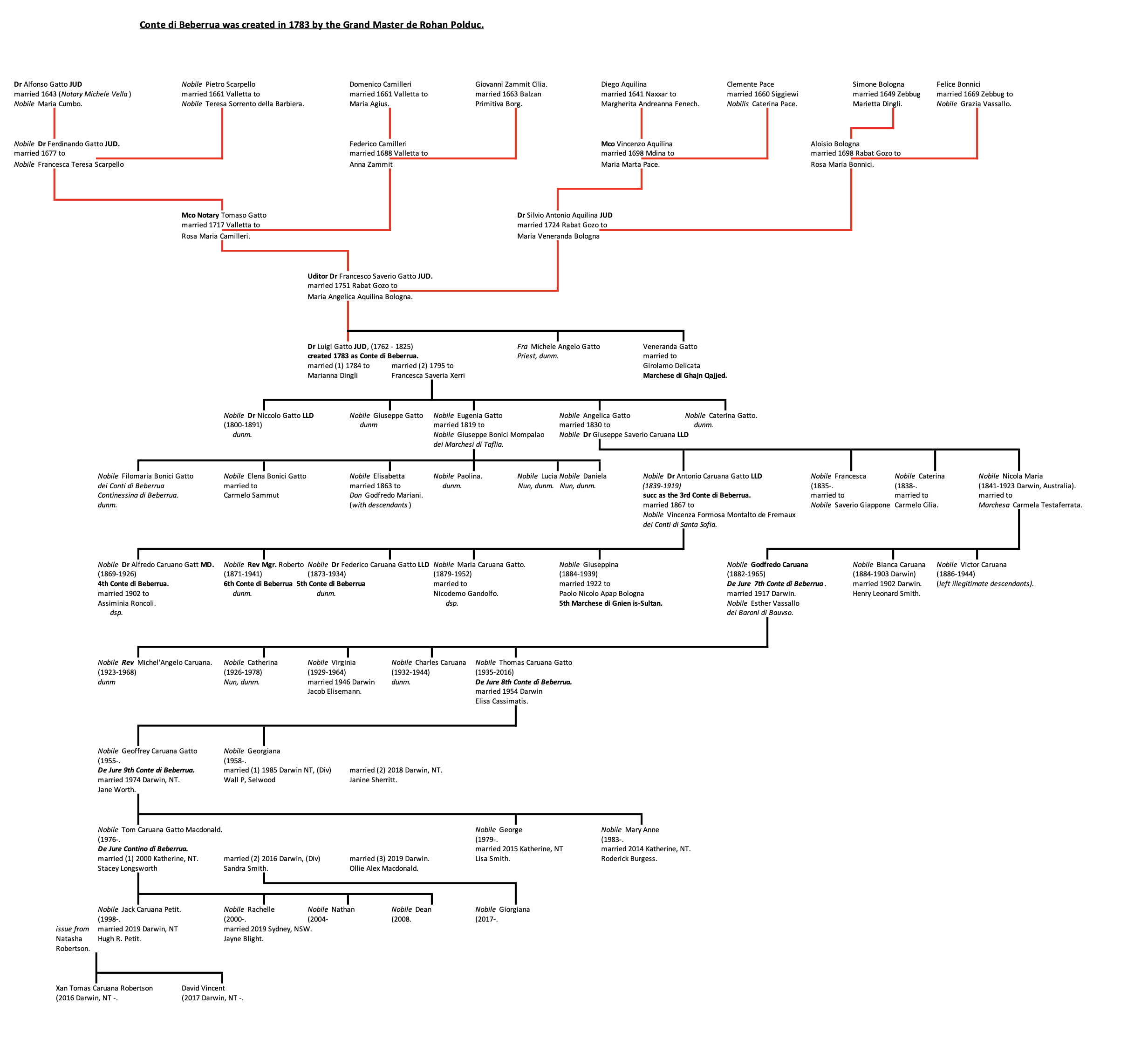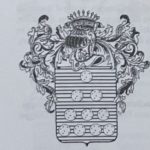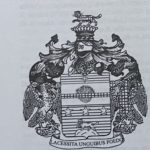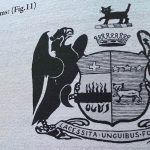Counts di Beberrua (cr: 1783).
Last update: 16-04-2023.
Granted to: Dr Luigi Maria Gatto JUD.
By: Emanuel de Rohan Polduc, Grand Master of Malta.
On: 1783 at Valletta.
British Crown recognition: 1883.
With Remainder to: “Tibi tantum, concedimus, et fidelitate nostra donamus, ac te Comitis hujusmodi tituolo decoramus et insignimus nec non ita nominari posse et debere”. The title of Conte di Beberrua was granted on the 23rd October 1783 by Grand Master Rohan to Luigi (Ludovico) Gatt, in the following terms: – Tibi tribuimus, concedimus, et fidelitate nostra donamus, ac te Comitis hujusmodi titulo decoramus et insignimus nec non ita nominari posse et debere. The terms of the grant are similar to those of the patents of the Barone diBuleben and the Marchese di San Giorgio in the sense that none of these original grants contain any provision for succession after the grantee. Such grants were by the Grand Master himself taken to be personal, and as such, they could only be extended on an application of the grantees themselves. According the 1878 Commissioner.
Correspondence and Report of the Commission appointed to enquire into the claims and grievances of the Maltese Nobility, May 1878, presented to both Houses of Parliament by Command of Her Majesty (C.-2033.) (
Nicolo was born much later after the 1783 grant. In fact, Nicola was born of the grantee’s second marriage, the grantee having remarried in 1795. Apart from the reasons explained in the Commissioner’s report , it is therefore unlikely that in 1783 the Grand Master ever contemplated the possibility that Ludovico was going to have any issue at all.
The claimant Dr. Nicolo Gatt pursued his claim to the title which was granted to his father, and in 1883, a Committee of five Titolati (namely Ciantar, Apap Bologna, De Piro, Manduca and Delicata) recommended to the British Secretary of State for the Colonies that Our opinion is that the title at the death of the grantee vested in Conte Nicolo Gatt LL.D., the only surviving son of the person first ennobled, and that it should continue to descend, de primogenito in primogenitum in infinitum, to the male descendants of the grantee. Under these circumstances we consider this title fully deserving the grace and favour of recognition from the Crown, that the bearer may have his name duly entered in the official list of Titolati. This recommendation was accepted by the Secretary of State for the Colonies.
Thus the adjusted succession as per the 1883 decision of the Secretary of State for the Colonies, allows Nicolo (or Nicola) Gatt to succeed Ludovico Gatt as the 2nd Count of Beberrua.
List of Title holders:
1. Dr Luigi Maria Gatto JUD, (d. 1825), 1st Conte, succeeded by his son.
2. Dr Nicola Gatto JUD, (d. 1891), 2nd Conte, succeeded by his nephew.
3. Dr Antonio Caruana Gatto MD, (d. 1919), 3rd Conte, succeeded by his son.
4. Dr Alfredo Caruana Gatto LLD, (d. 1926), 4th Conte, succeeded by his brother.
5. Dr Federico Caruana Gatto LLD, (d. 1934), 5th Conte, succeeded by his brother.
6. Rev Mgr Roberto Caruana Gatto, (d. 1941), 6th Conte, dormant.
Committee of Privileges of the Maltese Nobility ruling.
7. Nobile Maria Caruana Gatto Gandolfo, succeeded in 1945, (d. 1952), 7th Contessa, succeeded by her niece.
8. Marchesa Maria Teresa Apap Bologna Caruana Gatto Deguara, (d. 2014), 8th Contessa, succeeded by her son.
9. Nobile Paul Deguara Caruana Gatto, (1959-, 9th Conte.
Heir: Nobile Henry Deguara Caruana Gatto, (1960-.
Claimant🙁Senior male to male line).
7. Nobile Godfrey Caruana, (d. 1965), 7th de Jure Conte, succeeded by his son.
8. Nobile Thomas Caruana Gatto, (d. 2016), 8th de Jure Conte, succeeded by his son.
9. Nobile Godfrey Caruana Gatto, (1955 -, 9th de Jure Conte.
Heir: Nobile Jack Caruana Petit, (1998 -, de Jure Contino di Beberrua (Grandson) – has two sons born out of marriage, Xan Tomas, 2016 and David 2017.
Heir General: Nobile Nathan Caruana Petit, (2004 -., (brother of the Contino)
Line of Succession: (legitimate male to male succession): (as per date: 24-05-2020).
3. Nobile Dean Caruana Gatto, (2008 -, (brother of the Contino).
4. Nobile George Caruana Gatto, (1979 -, (son of the De Jure 9th Conte di Beberrua).
5. Nobile Godfrey III Caruana Gatt, (2019-, (son of Nobile George Gatto).
Articles relating to this title:
* Title of Count of Beberrua.
History
The title Conte di Beberrua is a title of Nobility in Malta. It was granted in 1783 by the penultimate Grandmaster of the Order of Saint John during its rule over the Maltese Islands. In 1878, an official investigation declared this title extinct. However in 1883, this title was revived.
Since 1975, titles of nobility are no longer recognized in the Republic of Malta by Act 29 of 1975 dated 17 October 1975.
Origin and Nature of title
The title of Conte di Beberrua was conferred by Grand Master Rohan on the 30th December 1783 upon Luigi or Ludovico Gatt, in the following terms: – “Tibi tribuimus, concedimus, et fidelitate nostra donamus, ac te Comitis hujusmodi tiulo decoramus et insignimus nec non ita nominari posse et debere.”
No land was attached to this title of nobility. The title was merely honorific and did not give rise to any right of possession of the land called Beberrua.
The terms of the grant are similar to those of the patents granted in 1777 to Barone Azzopardi and in 1778 to Marchese Barbaro, which contain no provision for the descent of the title to sons, heirs, descendents, and successors of the grantee. Nor does the grant state specifically that the title was created “ad vitam”.
The latter two grants, were by the same Grand Master taken to be personal, and as such, they were extended on an application of the grantees themselves, either to their first-born son exclusively, or as in the instance of Marchese Barbaro, to all their descendents for ever. However, no similar extension was made in regard to Ludovico Gatt.
In 1870 the Marchese Giorgio Crispo Barbaro published a compendium of the “Maltese Nobility and the Maltese Gentry holding Foreign Titles”. In that publication Crispo Barbaro does not include any reference to the title of Conte di Beberrua – See full text of Crispo Barbaro’s book at http://www.saidvassallo.com/SME/1870%20barbaro.pdf
However some time later, this title was claimed by Nicolo’ Gatt (who was the son of the aforesaid Ludovico). This claim together with other people’s claims to titles of nobility, was eventually investigated by a Commission as described below.
Some publications show a number of ladies as having succeeded this title as “Countesses of Beberrua”. These ladies are neither counted nor included here because the creation in favour of Ludovico Gattdoes not comprehend any remainder in favour of females.
Precedence enjoyed by the holder of the title of Conte di Beberrua
Long before the above creation, the then Grand Master Depuig had introduced in 1739 the concept of according a form of precedence to a holder of a title of nobility. The relative law is reproduced hereunder:-
Hosplis Mgr et Hierlem Sti. Sepulchri. – Per togliere le differenze di precedenze tra le persone che saranno promosse alla giurazie dell’ Universita’ della Notabile e della Valletta, vogliamo, ordiniamo e comandiamo che tutte siano precedue dagli infrascritti, e che fra queti si regoli la precedena call’ ordine seguente cioe’: Primieramente, chi fu Capitano della Verga della Sudetta Citta’ Notabile e nostra Isola di Malta.; Secondo. Il Titolato che ha un titolo fondato sopra un feudo in realta’ esistente qui, benche’ non lo possegga.; Terzo. Il titolato che non ha un titolo fondato sopra fondo realmenteesistente nel nostro Dominio, registrato che sia il titolo nella Cancelleria nella nostra Religione e nella Gran Corte della nostra Castellania, e pagato per i rispettivi registramenti il diritto di scudi cento sedici di questa moneta, da dividersi per meta’ tra la Cancelleria e la Castellania sudetta.; Quarto. Il discendente per linea mascolina da chi fu Capitano della Verga, se vive colle proprie rendite, e se i di lui ascendente intermedie vissero pure colle proprie rendite.; Quinto. Il discendente per linea mascolina da un titolo con titolo fondato sopra un feudo qui realmente esistente, se vive colle proprierendite, e se i suoi ascendenti intermedie cosi vissero; Sesto. Chi fu primo Giurato della Notabile; Settimo. Chi fu primo Giurato della Valletta; Ottavo. Il piu’ anziani di Giurazia di quella Universita’ dellaquale sara’ creato giurato.; Nono. Chi fu Giudice d’Appello Criminale o Civile della Gran Corte della Castellania e della Corte Capitanale e Governatoriale; Diecimo. Il Dottore di Leggi ed il Dottore di Medicina.: – Dichiariamo che fra le persone d’un stesso grado si deve attendere l’anzianita’ del titolo primordiale e che chiunque fu Giurato, se sara’ fatto Console di Mare, fra i quali s’attendera l’anzianitad’ufficio. Dat. In Palatio, die xvi. Septembris 1739 (f. Despuig)
On the basis of this enactment it follows that in when the title was created all of Luigi Gatt’s male-to-male descendants (“Il discendente per linea mascolina”) were made automatically entitled to a precedence.
The latter enactment was amended in 1795 by the same Grand Master Rohan as follows:
Hosplis Magr. Hierlem. Sti. Sepulchri, et Ordinis Sti Antonii, Viennensis Essendo una massima universalmente ricevuto, che il maggior lustro della Nobilta’ principalmente dipende dalla sua maggiore antichita’, niente che il piu’ giusto e ragionevole che il piu’ antico Nobile preceda il piu’ moderno. Siamo pertanto venuti nella determinazione di Ordinare che nel regolarsi la precedenza tra le persone Nobile di questo nostro Dominio, cosi’ primogeniti che cadetti indistintamente, si abbioa ad avere unicamente riguardo alla maggiore o minore antichita’ del titolo che nobilito le loro famiglie, e cio tanto se il titolo sara’ stato concesso da Noi o Nostri predecessori, che se lo avessero ottenuto da Principi esteri, purche’ pero sara’ stato questo debitamente registrato nella Nostra Cancelleria e Gran Corte della Castellania; nel consorso pero’ di ugual data quello nella di cui persona concorreranno piu’ titoli dovra’ essere preferito, all’ altro che ne avesse meno, secondo la graduazione stabilita nel Chirografo Magisteriale del Nostro Predecessore Gran Maestro Despuig di Gl. Em. Del 16 Sept 1739, quale in quelle parti che non contradicono la questa nostra disposizione intendiamo di pienamente confermare.Datum in Palatio die xvii Martii 1795 (f.) Rohan
In view of the latter enactment the Conte di Beberrua and his male-to-male descendants were to rank before the holder of any title created after that date and respective descendants. Therefore, it follows that the Conte di Beberrua ranks before the Marchese del Fiddien (created in 1785) Marchese della Taflia (1790) Marchese di Gnien is-Sultan (1792) and the Marchese di Ghajn Kajet(1796) even though all the latter titles purport a higher rank. The same position holds in regard to the respective male-to-male descendants. Conversely, the Conte di Beberrua ranks after the older creations (mostly barons) and the holders of noble fiefs.
Grand Master Rohan is also credited with codifying various laws in Malta. Amongst these, we find in the Code enacted in 1783 which states that the determining criteria of primogeniture in Malta operate in the following order:- Line (the first line excluding all the others), Degree (the closer degree of relationship excluding the remoter) Sex (the male sex being preferred to the female), and Age (the elder being preferred to the younger).
THE ROYAL COMMISSION APPOINTED TO ENQUIRE INTO THE CLAIMS OF THE MALTESE NOBILITY
After the Capitulation of the Order of Saint John the new French Rulers formally abolished all titles of nobility. (General Napoleon Bonaparte issued two orders dated 13 and 16 June 1798 prohibiting the use of any title “ORDRE (1) QUARTIER GENERAL DE MALTE, LE 25 PRAIRAL, AN VI (13 JUIN 1798): Le General en Chef ordonne……(ARTICLE 2.)… Toutes les armoires seront abbatues dans l’ espace de 24 heures. Il est defendu de porter dest livrees, ni aucune marque et titre distinctif de noblesse. ORDRE (2) AU QUARTIER GENERAL DE MALTE, LE 28 PRAIRAL, AN VI (16 JUIN 1798): Bonaparte Membre de l’Istitut National, General-en-Chef ordonne…(ARTICLE CINQUIEME)….Dix jours apres la publication du present ordre, il est defendu d’avoir des armoires soit dans l’interieur, soit a l’exterieur des maisons, de cacheter des lettres avec des armoires, ou de prendre des titres feodaux. ……(ARTICLE DOUZIEME)….Tous les contrevenants aux articles cidessous, seront condamnes pour la premier fois, a une amende du tiers de leurs revenus; pour la seconde fois, a trois mois de prison; pour la troisieme fois a un an de prison; pour la quatrieme fois, a la deportation de l’ile de Malte, et a la confiscation de la moitie de leurs biens. Il devra toujours y avoir 10 jours d’intervalle entre la recidive.”
Another Order was issued by Bosredon Ransijat, President of the Commission du Gouvernement dated 18 Messidor Year 6 (6 July 1798), where it was enacted that all honorary titles should be burnt on the 14th of that month and that every holder of a title should carry his patent at the Arbre de la Liberté.
The French in turn lost Malta in 1800 to a contingent raised by Captain Ball and Admiral Nelson. Malta later became a British Protectorate after the Treaty of Paris of 1814.
In time, the use of nobiliary titles was resumed. However, it appears that this use was unregulated.
Eventually, the British Secretary of State for the Colonies commissioned a report in 1876, on those titles alleged to have been conferred to Maltese families before the annexation of Malta to the British Dominions, namely 1800. The Commissioners’ Report and Supplemental Report were published in 1878 together with relative correspondence.
UNSUCCESSFUL CLAIM OF NICOLO’ GATT
In 1878, this title was claimed by Ludovico Gatt’s son, Nicolo’.
Explaining his claim, Gatt put forward several arguments which are substantially the following:-“That the title granted by the patent of 1783 contains all the elements of a real and proper feud, investiture, oath of fidelity, homage: that it must be consequently regulated by the feudal laws; that these laws hold feuds to be, of their own nature, perpetual and descendible to the sons, descendents, heirs and successors of the feudatory, according to the different cases, without the necessity of any designation of such heirs and successors in the patent of grant; that the designation of such heirs and successors in intended not to extend the grant, but to specify the nature of the feud: that the same Grand Master Rohan previously and subsequently to 1783 issued other patents of titles of nobility with the clause “tibi tantum”, or “tua naturali vita perdurante”, which restrictive clauses specify the personal nature of the title, and are not expressed in the patent granted to his father: and that in several Acts of the Local Government, under the British rule, and during the period of 52 years, his title has been constantly recognized.”
However, the Commissioners dismissed these arguments altogether. The Commissioners explained that everything depended on the meaning given by the same sovereign to other grants worded in an identical form. In this case, the creation in favour of Gatt contained no provision for the descent of the title to sons, heirs, descendents, and successors of the grantee. Given that the creation was similar to those granted in 1777 to Barone Azzopardi and in 1778 to Marchese Barbaro, the Commissioners could not regard the title as anything more than a personal one unless they were provided with proof of some form of extension.
Hence the Commissioners refused the claim of Nicolo’ Gatt, saying that the title had become extinct.
With regard to the “recognition” of the title which Nicolo’ claimed in his favour through the local administration under the British rule, the Commissioners recalled the fact that their Report was the first-ever careful enquiry into the origin, nature, and extent of the titles of Maltese nobility having been instituted. The continued explaining that no value was attached to the fact if in the period between 1800 till their Report, any person was designated by the prefix by which they were commonly called.
POSITION OF BRITISH SECRETARY OF STATE FOR THE COLONIES IN 1878
The Secretary of State agreed with the Commissioners. He explained that an act of presumed recognition under the British Government, (For example the styling of a gentleman as a baron, or count, or marquis in a passport, or in any other official document) could never be taken to have revived or perpetuated a title which has become extinct, or was otherwise without legal support. The Secretary of State emphasized that no public officer, not even a Secretary of State, has the power of conferring titles of honour, for which the personal sanction of Her Majesty is each case is necessary.
INTERCESSION ON BEHALF OF NICOLO’ GATT IN 1883 AND SUBSEQUENT REVIVAL OF TITLE BY BRITISH SECRETARY OF STATE FOR THE COLONIES
In 1883, a Committee of five Maltese nobleman submitted to the British Secretary of State for the Colonies their opinion that the title Nicolo Gatt being the only surviving son of the person first ennobled, should succeed the title and that it should continue to descend, “de primogenito in primogenitum in infinitum”, to the male descendants of the grantee.
This recommendation was accepted by the Secretary of State for the Colonies and Nicolo’ Gatt’s name was added to the official list of Titolati.
CONTROVERSIES
Nicolo’ Gatt’s male-to-male primogenial descendants are by virtue of the 1883 decision of the British Secretary of State entitled to succeed the title.
However, some publications show that this title may be succeeded by males descending in the female line, some times even showing females as holding this title. This would be consistent with the Rules of Primogeniture as enacted also by Grand Master Rohan. However, the application of this rule finds no basis in any official enquiry regarding the title in question. In fact neither the 1878 Report, nor the 1883 recommendation imply that a female is entitled to succeed the title of Conte di Beberrua. The 1883 recommendation only provides for a revival in favour of Nicolo’ Gatt’s “de primogenito in primogenitum in infinitum”.
In 1878, the Commissioners had already pointed out in their findings on the 1775 creation of “Barone della Marsa” that where only males are contemplated by the grant one cannot extend these terms to include females. There is nothing in the 1883 Recommendations which can be taken to extend this remainder.
OTHER ENTITLEMENTS
For the purposes of precedence amongst the Nobility in Malta, this title ranks according to antiquity of creation. According to the 1878 Report, this title was considered before the title of Marchese del Fiddien granted by Grand Master Rohan to Salvatore Mallia Tabone on the 15 October 1785 and after the title of Marchese di San Giorgio granted by the same Grand Master to Carlo Antonio Barbaro on the 6 September 1778.
As from the year 1886, the holder of this title of Nobility became entitled to be styled “The Most Noble”. The presumed successor of this title is by custom entitled to be styled Contino di Beberrua.
Other descendants of the various holders of this title are by custom entitled to be styled dei Conti di Beberrua.
PRESENT DAY
Since 1975, titles of nobility are no longer recognized in the Republic of Malta by Act 29 of 1975 dated 17 October 1975.
GENEALOGY
The published genealogy of the Conte di Beberrua is as follows:
Original creation (1783)
· Luigi Gatt, Conte di Beberrua
Revival of title (1883)
· Nicolo’ Gatt (Luigi’s son)
REFERENCES
PRIMARY REFERENCES
(1783 GRANT):
1. Grant of title of Conte di Beberrua by Grand Master Rohan to Luigi (Ludovico) Gatt on the 23 October 1783 (Recorded in the Archives of the Order, National Library, Malta Ref. AOM 587, ff. 294r-299r)
(1883 Revival):
1. REPORT OF THE COMMITTEE OF PRIVILEGES OF THE MALTESE NOBILITY ON THE CLAIMS OF CERTAIN MEMBERS OF THAT BODY WITH THE SECRETARY OF STATE’S REPLY, AUGUST 1883, PRESENTED TO BOTH HOUSES OF PARLIAMENT BY COMMAND OF HER MAJESTY (C-3812)
SECONDARY REFERENCES (HISTORY):
(1) CORRESPONDENCE AND REPORT OF THE COMMISSION APPOINTED TO ENQUIRE INTO THE CLAIMS AND GRIEVANCES OF THE MALTESE NOBILITY, MAY 1878, PRESENTED TO BOTH HOUSES OF PARLIAMENT BY COMMAND OF HER MAJESTY (C.-2033.):
(2) REPORT OF THE COMMITTEE OF PRIVILEGES OF THE MALTESE NOBILITY ON THE CLAIMS OF CERTAIN MEMBERS OF THAT BODY WITH THE SECRETARY OF STATE’S REPLY, AUGUST 1883, PRESENTED TO BOTH HOUSES OF PARLIAMENT BY COMMAND OF HER MAJESTY (C-3812)
(3) Copies or Extracts of Correspondence with reference to the Maltese Nobility (In continuation of C3812, August 1883), presented to both Houses of Parliament by Command of Her Majesty May 1886 (C-4628a)
(4) John Montalto, “The Nobles of Malta 1530-1800” (Midsea Books, Malta, 1980)
TERTIARY REFERENCES (PUBLISHED GENEALOGY):
(1) Crispo Barbaro “THE NOBLES OF MALTA, AND THE MALTESE GENTRY HOLDING FOREIGN TITLES AS AT PRESENT EXISTING BY GEO. G.C.’A. CRISPO BARBARO MARQUIS OF ST. GEORGE” MALTA:- A.D. MDCCCLXX (THE ANGLO-MALTESE PRESS, MALTA, 1870)”
(2) Charles Gauci “THE GENEALOGY AND HERALDRY OF THE NOBLE FAMILIES OF MALTA” (GULF PUBLISHING, MALTA, 1981)“
(3) Charles Gauci A GUIDE TO THE MALTESE NOBILITY” (PEG PUBLICATIONS, MALTA, 1986)
(4) Charles Gauci “THE GENEALOGY AND HERALDRY OF THE NOBLE FAMILIES OF MALTA VOLUME TWO ” (PEG PUBLICATIONS, MALTA, 1992)
(5) Charles Gauci “THE GENEALOGY AND HERALDRY OF THE NOBLE FAMILIES OF MALTA VOLUME ONE ” (PEG PUBLICATIONS, MALTA, 2002)
.






